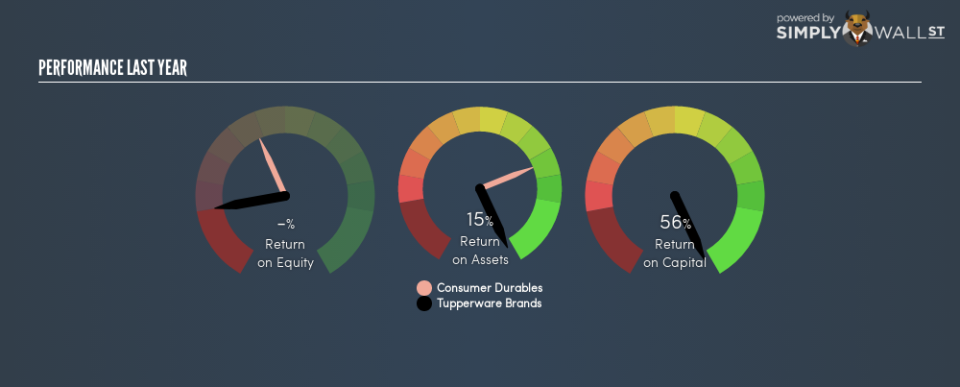Tupperware Brands Corporation (NYSE:TUP) Earns Among The Best Returns In Its Industry

Want to help shape the future of investing tools? Participate in a short research study and receive a 6-month subscription to the award winning Simply Wall St research tool (valued at $60)!
Today we’ll evaluate Tupperware Brands Corporation (NYSE:TUP) to determine whether it could have potential as an investment idea. In particular, we’ll consider its Return On Capital Employed (ROCE), as that can give us insight into how profitably the company is able to employ capital in its business.
First of all, we’ll work out how to calculate ROCE. Then we’ll compare its ROCE to similar companies. Last but not least, we’ll look at what impact its current liabilities have on its ROCE.
What is Return On Capital Employed (ROCE)?
ROCE measures the ‘return’ (pre-tax profit) a company generates from capital employed in its business. In general, businesses with a higher ROCE are usually better quality. Overall, it is a valuable metric that has its flaws. Author Edwin Whiting says to be careful when comparing the ROCE of different businesses, since ‘No two businesses are exactly alike.’
How Do You Calculate Return On Capital Employed?
The formula for calculating the return on capital employed is:
Return on Capital Employed = Earnings Before Interest and Tax (EBIT) ÷ (Total Assets – Current Liabilities)
Or for Tupperware Brands:
0.56 = US$317m ÷ (US$1.3b – US$740m) (Based on the trailing twelve months to December 2018.)
Therefore, Tupperware Brands has an ROCE of 56%.
See our latest analysis for Tupperware Brands
Is Tupperware Brands’s ROCE Good?
ROCE is commonly used for comparing the performance of similar businesses. Using our data, we find that Tupperware Brands’s ROCE is meaningfully better than the 11% average in the Consumer Durables industry. I think that’s good to see, since it implies the company is better than other companies at making the most of its capital. Setting aside the comparison to its industry for a moment, Tupperware Brands’s ROCE in absolute terms currently looks quite high.
Our data shows that Tupperware Brands currently has an ROCE of 56%, compared to its ROCE of 33% 3 years ago. This makes us think about whether the company has been reinvesting shrewdly.
When considering this metric, keep in mind that it is backwards looking, and not necessarily predictive. ROCE can be misleading for companies in cyclical industries, with returns looking impressive during the boom times, but very weak during the busts. ROCE is only a point-in-time measure. What happens in the future is pretty important for investors, so we have prepared a free report on analyst forecasts for Tupperware Brands.
Do Tupperware Brands’s Current Liabilities Skew Its ROCE?
Short term (or current) liabilities, are things like supplier invoices, overdrafts, or tax bills that need to be paid within 12 months. Due to the way ROCE is calculated, a high level of current liabilities makes a company look as though it has less capital employed, and thus can (sometimes unfairly) boost the ROCE. To counter this, investors can check if a company has high current liabilities relative to total assets.
Tupperware Brands has total liabilities of US$740m and total assets of US$1.3b. Therefore its current liabilities are equivalent to approximately 57% of its total assets. Tupperware Brands boasts an attractive ROCE, even after considering the boost from high current liabilities.
What We Can Learn From Tupperware Brands’s ROCE
In my book, this business could be worthy of further research. Of course, you might find a fantastic investment by looking at a few good candidates. So take a peek at this free list of companies with modest (or no) debt, trading on a P/E below 20.
For those who like to find winning investments this free list of growing companies with recent insider purchasing, could be just the ticket.
To help readers see past the short term volatility of the financial market, we aim to bring you a long-term focused research analysis purely driven by fundamental data. Note that our analysis does not factor in the latest price-sensitive company announcements.
The author is an independent contributor and at the time of publication had no position in the stocks mentioned. For errors that warrant correction please contact the editor at editorial-team@simplywallst.com.

 Yahoo Finance
Yahoo Finance 
